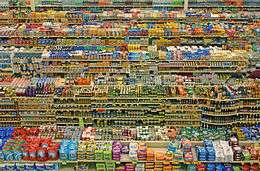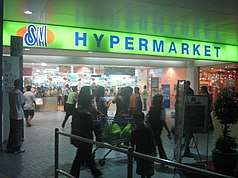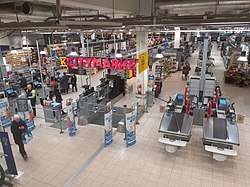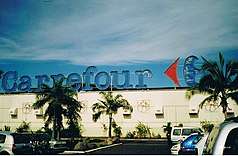Hypermarket
A "hypermarket" (sometimes called a "supercenter" or "superstore") is a big-box store combining a supermarket and a department store.[1] The result is an expansive retail facility carrying a wide range of products under one roof, including full groceries lines and general merchandise. In theory, hypermarkets allow customers to satisfy all their routine shopping needs in one trip. The term hypermarket (French: hypermarché) was coined in 1968 by French trade expert Jacques Pictet.[2]
Hypermarkets, like other big-box stores, typically have business models focusing on high-volume, low-margin sales. Typically covering an area of 5,000 to 15,000 square metres (54,000 to 161,000 sq ft), they generally have more than 200,000 different brands of merchandise available at any one time. Because of their large footprints, many hypermarkets choose suburban or out-of-town locations that are easily accessible by automobile.
History
Canada
Loblaws established its Real Canadian Superstore chain in 1979. It sells mainly groceries, while also retailing clothing, electronics and housewares. Its largest competitor in Canada is Walmart. These are the two major Canadian hypermarkets.
Europe
The first European hypermarket is commonly mistaken to be the Carrefour store that opened in 1963, at Sainte-Geneviève-des-Bois, France,[3] The co-founders were influenced by the teachings of Colombian-born American marketing executive Bernardo Trujillo, who taught executive education as part of the NCR Corporation's marketing campaign.[4] However, the Belgian retailer Grand Bazar preceded Carrefour by two years when it opened three hypermarkets in a short span in 1961 under the name SuperBazar after Belgian law restricting the size of department stores was abolished in January 1961. The first SuperBazar, opened in Bruges on 9 September 1961, initially designed to become a non-food department store, however only covered a surface area of 3,300 square metres (36,000 sq ft), and was later converted into a regular supermarket. The substantially larger store that opened a week later in Auderghem near Brussels, covering 9,100 m2 (98,000 sq ft), is regarded as a more proper hypermarket that brought the concept to fruition. [5] It was Belgian market development engineer Maurice Cauwe, who adopted the concept from his frequent trips to the United States, particularly inspired from the Grand Union's "Grand Way" center in Paramus, New Jersey.[6]
Japan
The predecessor to Ito Yokado was founded in 1920 selling western goods, went public in 1957, and switched to that name in 1965. Seibu Department Stores was founded in 1956, and opened up its grocery chain Seiyu Group in 1963. Isao Nakauchi founded the first Daiei in Kobe in 1957, selling clothing, electronics, furniture and groceries all in one store. Jusco was created in 1970, and eventually became known as ÆON.
In Japanese, hypermarkets are known as 総合スーパー (Sougou Suupaa, General Merchandise Stores). There is a distinction in Japanese between スーパー (Supers) and デパート (Departs) with the former being discounters, but the latter selling luxury brand clothing and quite often high-end groceries as well.
United States
Americans typically refrain from using the term "hypermarket", instead calling such establishments "big-box stores", "supercenters", or "superstores". Until the 1980s, large stores combining food and non-food items were unusual in the United States, although early predecessors of today's hypermarkets existed.[7]
The Pacific Northwest chain Fred Meyer, now a division of the Kroger supermarket company, opened the first suburban one-stop shopping center in 1931 in the Hollywood District of Portland, Oregon. The store's innovations included a grocery store alongside a drugstore plus off-street parking and an automobile lubrication and oil service. In 1933, men's and women's wear was added, and automotive department, housewares, and other nonfood products followed in succeeding years. In the mid 1930s, Fred Meyer opened a central bakery, a candy kitchen, an ice cream plant, and a photo-finishing plant, which supplied the company's stores in Portland and neighbouring cities with house brands such as Vita Bee bread, Hocus Pocus desserts, and Fifth Avenue candies. By the 1950s, Fred Meyer began opening stores that were 4,200 to 6,500 m2 (45,000 to 70,000 sq ft), and the 1960s saw the first modern-sized Fred Meyer hypermarkets.[8]
The Midwest chain Meijer, which today operates some 235 stores in six US states and calls the hypermarket format "supercenter",[9] opened its first such "super center" in Grand Rapids, Michigan, in June 1962, under the brand name "Thrifty Acres".[10][11]
In the late 1980s and early 1990s, the three major US discount store chains – Walmart, Kmart and Target – started developing hypermarkets. Wal-Mart (as it was known before its late-2000s rebranding as Walmart) introduced Hypermart USA in 1987, followed by Wal-Mart Supercenter and Auchan in 1988;[12] Kmart opened its first Super Kmart (originally called Kmart Super Center) in 1991;[13] and Target came with the first Target Greatland stores in 1990, followed by the larger SuperTarget stores in 1995.[14] Most Greatland stores have since been converted to SuperTarget stores, while some have been converted into regular Target stores with the exception of 2 entrances (one example of this is the Antioch, California location).
In the early 1990s, US hypermarkets also began selling fuel. The idea was first introduced in the 1960s, when a number of supermarket chains and retailers like Sears tried to sell fuel, but it didn't generate sufficient consumer interest at the time. Today there are approximately 4,500 hypermarket stores in the US selling fuel, representing an estimated 53 billion litres (14 billion US gallons) sold each year.[15]
Size
The average Walmart Supercenter covers around 16,500 m2 (178,000 sq ft), with the largest ones covering 24,000 m2 (260,000 sq ft).[16] A typical Carrefour hypermarket still covers 10,000 m2 (110,000 sq ft), while the European trend in the 2000s has rather turned towards smaller hypermarkets of 3,000 to 5,000 m2 (32,000 to 54,000 sq ft).[17] In France, INSEE defines hypermarkets (French: hypermarché/s) as non-specialized markets with a minimum size of 2,500 m2 (27,000 sq ft).[18]
Success
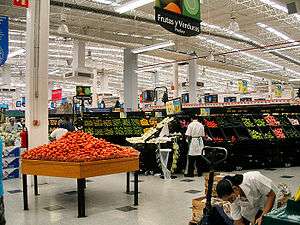
After the successes of super- and hyper-markets and amid fears that smaller stores would be forced out of business, France enacted laws that made it more difficult to build hypermarkets and also restricted the amount of economic leverage that hypermarket chains can impose upon their suppliers (the Loi Galland).
In France, hypermarkets are generally situated in shopping centers (French: centre commercial or centre d'achats) outside cities, though some are present in the city center. They are surrounded by extensive car parking facilities, and generally by other specialized superstores that sell clothing, sports gear, automotive items, etc.
In Japan, hypermarkets may be found in urban areas as well as less populated areas. The Japanese government encourages hypermarket installations, as mutual investment by financial stocks are a common way to run hypermarkets. Japanese hypermarkets may contain restaurants, manga (Japanese comic) stands, Internet cafes, typical department store merchandise, a full range of groceries, beauty salons and other services all inside the same store. A recent trend has been to combine the dollar store concept with the hypermarket blueprint, giving rise to the "hyakkin plaza"—hyakkin (百均) or hyaku en (百円) means 100 yen (roughly 1 US dollar).
Future
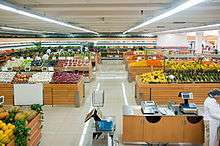
Despite its success, the hypermarket business model may be under threat from on-line shopping and the shift towards customization according to analysts like Sanjeev Sanyal, Deutsche Bank's Global Strategist.[19] Sanyal has argued that some developing countries such as India may even skip the hypermarket stage and directly go online.[20]
Warehouse club
Another category of stores sometimes included in the hypermarket category is the membership-based wholesale warehouse clubs that are popular in North America, pioneered by Fedco and today including Sam's Club, a division of Walmart; Costco, in which Carrefour owned some shares[21] from 1985 to 1996; BJ's Wholesale Club on the East Coast; and Clubes City Club in Mexico. In Europe, Makro (owned by METRO AG) leads the market.
However, warehouse clubs differ from hypermarkets in that they have sparse interior decor and require paid membership. In addition, warehouse clubs usually sell bigger packages and have fewer choices in each category of items.
References
- Staff, Investopedia (2007-06-24). "Hypermarket". Investopedia. Retrieved 2018-09-26.
- Grimmeau 2013, p. 3.
- Jean-Mark Villermet, Naissance de l'hypermarche, 1991, ISBN 2-200-37263-9, Colin (publisher).
- "Bernardo Trujillo, l'accoucheur des grandes surfaces". Les Echos. 8 December 1999. Retrieved 10 February 2018.
- Grimmeau 2013, pp. 1–3.
- Grimmeau 2013, pp. 2; 7.
- Grimmeau 2013, p. 8.
- FundingUniverse: Fred Meyer Stores, Inc. History Linked 2014-01-09
- Meijer website: Our Company Archived 2014-02-07 at the Wayback Machine Linked 2014-01-09
- Meijer website: Our History Linked 2014-01-09
- "Column: Meijer's first Super center past its prime but full of good memories". MLive.com. Retrieved 30 July 2015.
- "Walmart Corporate - We save people money so they can live better". Retrieved 30 July 2015.
- "Sears Holdings Corporation - Corporate Website". Archived from the original on 20 October 2008. Retrieved 30 July 2015.
- Target website: Target through the years Linked 2014-01-09
- The History of Gasoline Retailing Archived 2011-03-24 at the Wayback Machine
- Paul Ausick (22 March 2014). "Walmart Now Has Six Types of Stores". 24/7 Wall Street. Retrieved 17 June 2016.
- David Jolly (27 January 2012). "Carrefour Rethinks Its 'Bigger Is Better' Strategy". New York Times. Retrieved 17 June 2016.
- La situation du commerce en 2014 [The situation of commerce in 2014] (PDF) (Report) (in French). INSEE. 18 December 2015. Retrieved 17 June 2016.
- "Sanjeev Sanyal on The Customization Revolution - Project Syndicate". Project Syndicate. Retrieved 30 July 2015.
- "Sanjeev Sanyal on Clicks over Bricks in India - Project Syndicate". Project Syndicate. Retrieved 30 July 2015.
- Robert Spector, "Carrefour enters U.S. via share in Costco", Supermarket News, January 1985.
Bibliography
- Grimmeau, Jean-Pierre (10 June 2013). "A forgotten anniversary: the first European hypermarkets open in Brussels in 1961". Brussels Studies (67). ISSN 2031-0293. Retrieved 28 March 2020.CS1 maint: ref=harv (link)
External links
| Wikimedia Commons has media related to Supermarkets. |
